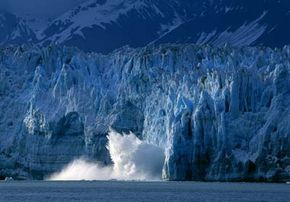Iceberg Basics
An iceberg is a massive chunk of ice floating in the ocean. It isn't sea ice or pack ice, which forms as the result of ocean water freezing. An iceberg was once part of a glacier, but it broke off, fell into the ocean and floated away. Icebergs are made of freshwater. They can have very irregular shapes, like mountains of ice, or they can be flat with steep sides, like a plateau of ice.
Since icebergs are made completely out of ice, let's take a minute to talk about ice. It's the solid phase of water, reached at a temperature of 32 degrees Fahrenheit for pure freshwater. Saltwater has a lower freezing temperature -- essentially, any molecules that aren't water molecules get in the way of the water molecules when they try to "line up" and form ice. Saltwater also has a greater density (amount of mass for a given volume) than freshwater because those extra molecules are heavier than plain water molecules. Ice is unique among solids in that it is the only solid that's less dense than the liquid phase of the same material. When water freezes, the molecules fit themselves into a crystalline shape. The particular structure of ice leaves lots of extra space between the molecules, reducing the density of ice. This is why icebergs float, and it will allow us to figure out how much of an iceberg lies unseen below the surface, which we'll get to shortly.
Advertisement
A glacier is a massive slab of ice and snow that can be hundreds of miles long and thousands of feet thick. Glaciers form when the amount of snow that melts in the summer is less than the amount of snow that falls in winter, resulting in a gradual buildup of snow and ice. Glaciers "flow" downhill at a very slow rate under the force of their own weight, eventually reaching the ocean. At the coast, the ice extends out beyond the land, floating on the water and forming an ice shelf. The weight of the ice combines with tidal motions raising and lowering the shelf to create fissures in the ice. Eventually, a chunk of ice will separate from the glacier, a process known as calving. This can be incredibly spectacular, with massive ice slabs splashing down into the ocean creating enormous waves. Other times, the newly formed iceberg simply floats away.
Glacial ice (and therefore icebergs) is made from snowfall, which is freshwater. That's why icebergs are made from freshwater, not saltwater.
